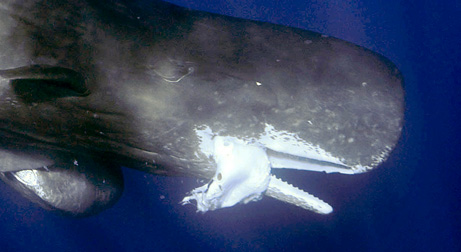Call me disturbed.
 (Source)
(Source)
Figure 2. Bats caught by spiders. A – Adult female Avicularia urticans feeding on a Greater Sac-winged Bat (Saccopteryx bilineata) on the side of a palm tree near the Rio Yarapa, Peru (photo by Rick West, Victoria, Canada; report # 1). B – Adult Proboscis Bat (Rhynchonycteris naso) entangled in a web of Argiope savignyi at the La Selva Biological Station, northern Costa Rica (photo by Mirjam Kno¨ rnschild, Ulm, Germany; report # 14). C – Dead bat (presumably Centronycteris centralis) entangled in an orb-web in Belize (photo by Carol Farneti-Foster, Belice City, Belize; report # 12). D – Dead bat (Myotis sp.) entangled in a web of Nephila clavipes in La Sirena, Corcovado National Park, Costa Rica (photo by Harald & Gisela Unger, Ko¨ ln, Germany; report # 17). E – A bat caught in the web of an araneid spider (possibly Eriophora sp.) in Tortuguero National Park, Costa Rica (photo by Cassidy Metcalf, USA; report # 18). F – Live bat trapped in web of Nephilengys cruentata in a thatch roof at Nisela Lodge, Swaziland (photo by Donald Schultz, Hollywood, USA; report # 47). G – Volant juvenile Proboscis Bat (Rhynchonycteris naso) entangled in web of Nephila clavipes photographed in a palm swamp forest near Madre de Dios, Peru (photo by Sam Barnard, Colorado Springs, USA; report # 7). H – Dead bat entangled in web of a female Nephila clavipes in tropical rainforest in the middle of the Rio Dulce River Canyon near Livingston, Guatemala (photo by Sam & Samantha Bloomquist, Indianapolis, USA; report # 11). I – Dead bat (Rhinolophus cornutus orii) caught in the web of a female Nephila pilipes on Amami-Oshima Island, Japan (photo by Yasunori Maezono, Kyoto University, Japan; report # 35). J, K – A small bat (superfamily Rhinolophoidea) entangled in web of Nephila pilipes at the top of the Cockatoo Hill near Cape Tribulation, Queensland, Australia (photo by Carmen Fabro, Cockatoo Hill, Australia; report # 39). The spider pressed its mouth against the dead, wrapped bat, indicating that it was feeding on it. A Nephila pilipes male also present in the web (K) may have been feeding on the bat as well. L – Dead vespertilionid bat entangled in the web of a female Nephila pilipes in the Aberdeen Country Park, Hong Kong (photo by Carol S.K. Liu from AFCD Hong Kong, China; report # 32).
Filed under: Bats, Spiders | Comments Off on Interesting Science Picture XVIII: Spiders Eat Bats




